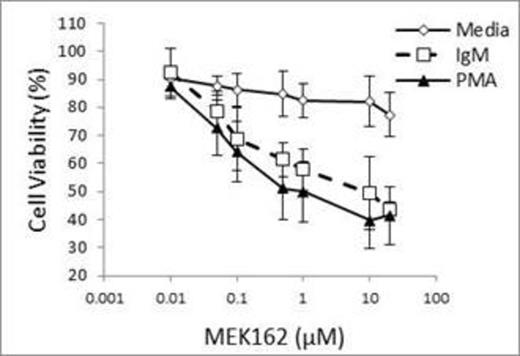Abstract
BACKGROUND Chronic Lymphocytic Leukemia (CLL) is characterised by the clonal expansion of apoptosis resistant B-lymphocytes. However, in vitro and in the absence of pro-survival factors primary CLL cells undergo spontaneous apoptosis.
B-cell receptor (BCR) signalling plays a major role in the survival and proliferation of CLL cells, which is highlighted by the clinical efficacy of the Btk and PI3-kinase inhibitors, ibrutinib and idelalisib. Mitogen activated protein kinase (MAPK) is an important mediator of signals downstream of both Btk and PI3-kinase but few studies have shown that inhibitors of MEK1/2, a critical component in the MAPK pathway, have any potential benefit for therapy of CLL.
METHODS We sought to investigate the potential of the MEK1/2 inhibitor MEK162 against CLL cells in vitro. To mimic the tonic BCR stimulation experienced in vivo, primary CLL cells were stimulated using an immobilised antibody to IgM or were treated with PMA, a less specific B-cell activator which promotes protein kinase C-dependent MAPK-ERK1/2 signaling. Sensitivity to MEK162 and effects on MAPK-ERK1/2 pathway activity were assessed by 3-(4,5-dimethylthiazol-2-yl)-2,5-diphenyltetrazolium bromide (MTT) assay and western blot analyses respectively.
RESULTS MEK162 treatment of CLL cells cultured in media alone resulted in a modest but significant (P < 0.01) reduction in cell viability; 20µM MEK162 reduced the proportion of viable cells remaining after 48 h to 77.40 +/- 7.81 % relative to vehicle-treated controls. In contrast, BCR stimulation through IgM ligation promoted cell survival 3.2 +/- 1.01 fold and sensitised CLL cells to MEK162; 20µM MEK162 reduced the proportion of viable cells by 56.28 +/- 2.37 % (P < 0.001 relative to control). A similar effect was observed in response to PMA stimulation; cell viability increased 1.78 +/- 0.15 fold and was reduced by 59.55 +/- 10.33 % (P < 0.001 relative to control) following treatment with 20µM MEK162 (Figure 1). At concentrations > 0.05 µM MEK162 was significantly (P < 0.05) more effective against CLL cells stimulated with either anti-IgM or PMA than against cells cultured in media alone.
By western blotting we observed low levels of MAPK-ERK1/2 activity in cells cultured in media alone, which we suggest may contribute to the spontaneous apoptosis of these cells and the low degree of sensitivity to MEK162 under these conditions. We confirmed that stimulation with either IgM or PMA results in activation of MAPK-ERK1/2 and show that this response can be effectively blocked using MEK162. The effects of anti-IgM and PMA on cell survival and response to MEK162 were independent of ZAP-70 expression or ATM/TP53 functional status.
CONCLUSIONS Our data illustrate the important role of MAPK-ERK1/2 activity in BCR-mediated CLL cell survival and suggest that MEK162 may have potential for CLL therapy. These data highlight the importance of employing appropriate culture conditions in order to make accurate assessments concerning the efficacy of novel agents for the treatment of CLL.
Stimulation with IgM or PMA sensitises B-CLL cells to MEK1/2 inhibition by MEK162.
Stimulation with IgM or PMA sensitises B-CLL cells to MEK1/2 inhibition by MEK162.
Mulligan:Roche: Consultancy, Honoraria, Research Funding, Speakers Bureau; Sanofi Aventis: Research Funding; Janssen: Consultancy, Honoraria, Speakers Bureau; Celgene: Consultancy, Honoraria.
Author notes
Asterisk with author names denotes non-ASH members.


This feature is available to Subscribers Only
Sign In or Create an Account Close Modal